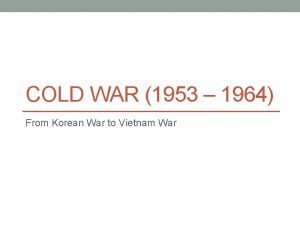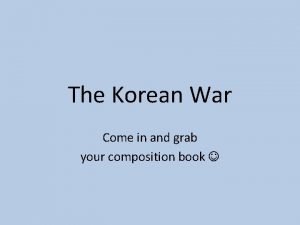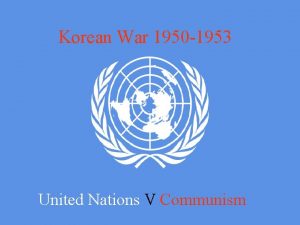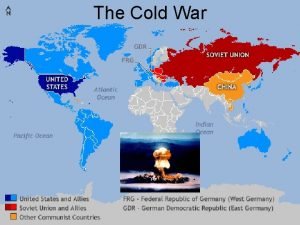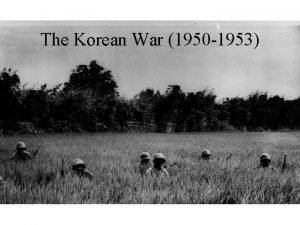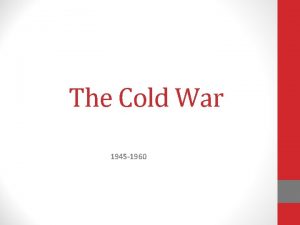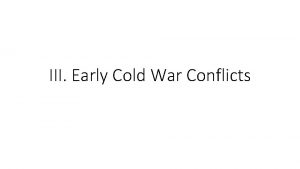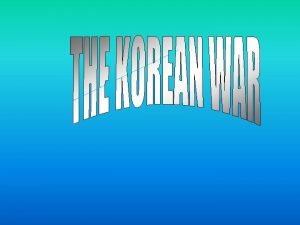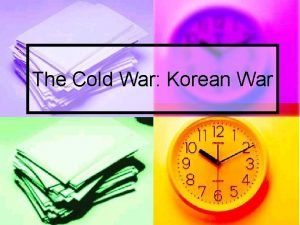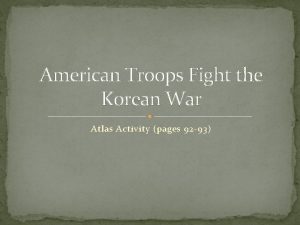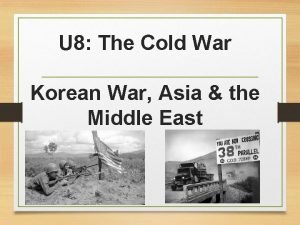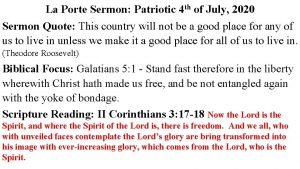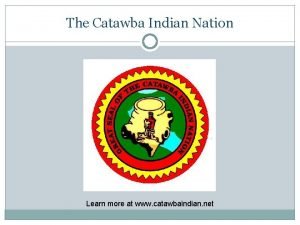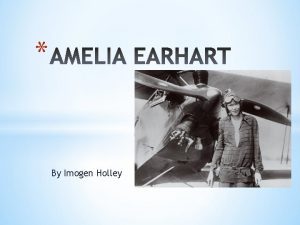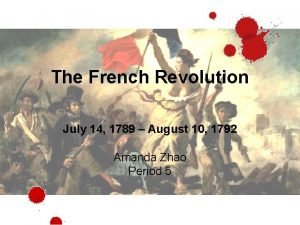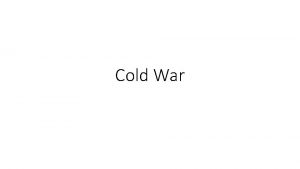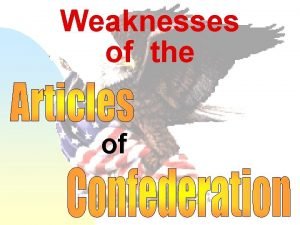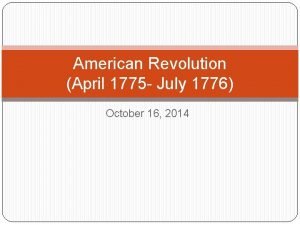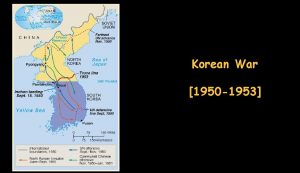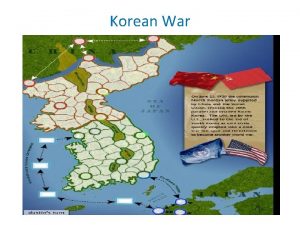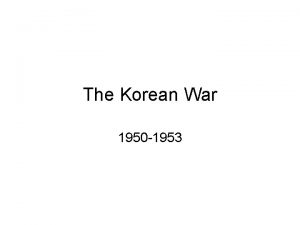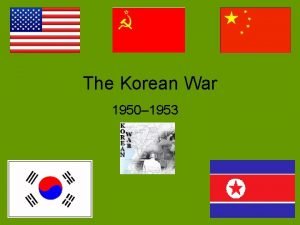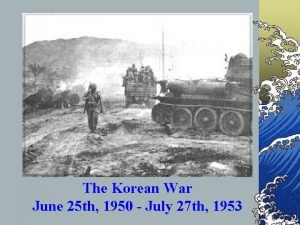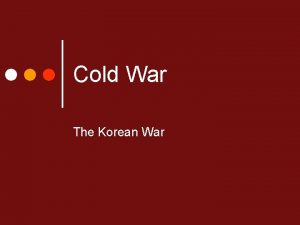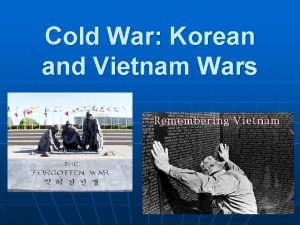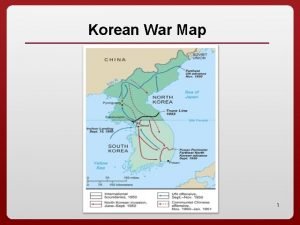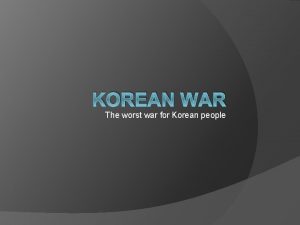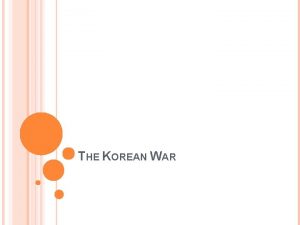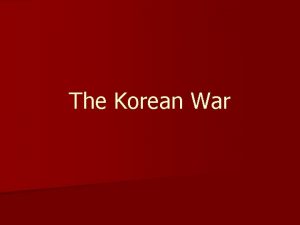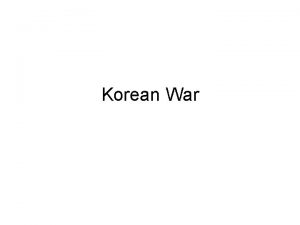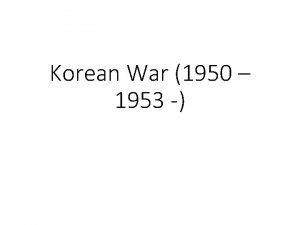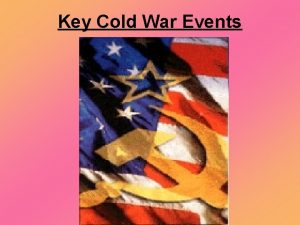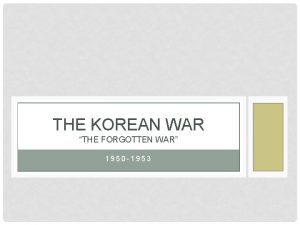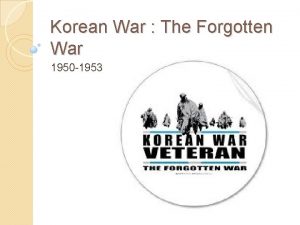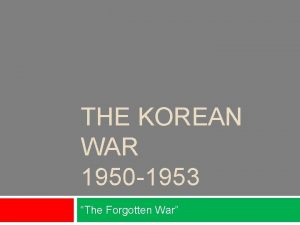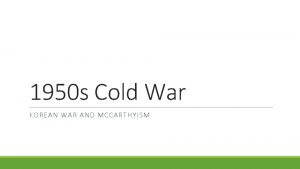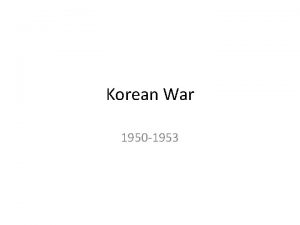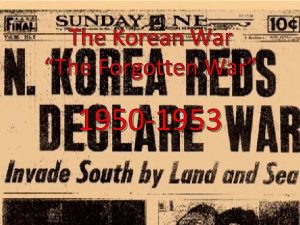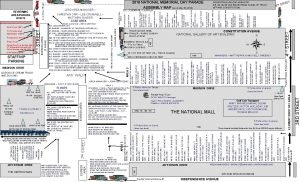The Korean War June 25 th 1950 July















































- Slides: 47

The Korean War June 25 th, 1950 - July 27 th, 1953

In 1948 two different governments were established on the Korean Peninsula, fixing the South-North division of Korea. The Republic of Korea (South Korea) was born south of the 38 th parallel and the Democratic People's Republic of Korea (North Korea) north of it.


On August 15, 1948, the Republic of Korea (R. O. K. ) was established. Syngman Rhee became the republic's first president. On September 9, 1948, the Democratic People's Republic of Korea (D. P. R. K. ) was established in the north under Kim Il Sung.

Syngman Rhee

Guerrilla fighting in the south and clashes between southern and northern forces along the 38 th parallel intensified during 1948 -50.

North Korea, having obtained a massive amount of weapons from the Soviet Union and the Chinese Communist Party, prepared to invade the South to establish communism in the entire peninsula.

By mid-1950 North Korean forces numbered between 150, 000 and 200, 000 troops, with 210 fighter planes and 280 tanks. Soviet equipment had also been pouring into North Korea in early 1950.

These forces were to fight the ill-equipped South Korean army of less than 100, 000 men--an army lacking in tanks, heavy artillery, and combat airplanes, plus a coast guard of 4, 000 men and a police force of 45, 000 men.

In the predawn hours of Sunday, June 25, 1950, the North Korean forces, spearheaded by tanks and self-propelled guns, unleashed all-out attacks across the 38 th parallel.


The US, with the United Nations, came to the aid of South Korea, fearing that inaction in Korea would be interpreted as appeasement of communist aggression elsewhere in the world.

When the Soviets made the mistake of walking out of an emergency session of the United Nations Security Council, that body directed that the United Nations would send troops to South Korea. A 3 -year "police action" resulted.


The North Koreans quickly crushed South Korean defenses at the 38 th parallel. South Korea's army was simply overwhelmed. The capital of Seoul fell in three days.


The suburbs of Seoul, destroyed by artillery and air strikes. Photo taken 08/20/1951.

By early August, South Korean forces were confined in the southeastern corner of the peninsula. Fifty miles short of the sea, a defensive perimeter (labeled the "Pusan Perimeter") was formed. The rest of the territory was in the hands of the North Korean army.



General Mac. Arthur felt that the North Koreans were vulnerable to an amphibious envelopment. A landing at Inch'on, the Yellow Sea port just twenty-five miles west of Seoul, would cut North Korean supply routes.


The assault on Inch'on on 15 September 1950 encountered light resistance and UN forces steadily pushed inland. This was a huge confidence builder for the forces and particularly Mac. Arthur.

The course of the war changed abruptly, and within weeks much of North Korea was taken by United States and South Korean forces. In October, the North Korean capital of Pyongyang was captured and ROK troops reached the Yalu River.

Mac. Arthur ordered an advance to the northern Korean border with China at the Yalu River. Victory seemed at hand, but within 24 hours the situation suddenly changed. When Kim's regime was nearly dead, the Soviet Union did very little to save it -- China picked up the pieces.

Truman and Mac. Arthur

The Chinese Army massed 850, 000 troops north of the Yalu River. The UN force's advance had continued despite warnings of a massive Chinese intervention.

Mao Tse Tung feared that the Allies would not stop in Korea, but would continue across the Yalu River into China and attempt to overthrow communism in mainland China.


The US Eighth Army counterattacked, recapturing Seoul by mid-March 1951, and then advancing to just below the 38 th parallel.



Mac. Arthur had Truman’s consent to take over all of North Korea. However, the President did not agree to his suggestions of bombing China, including use of the atomic bomb. After Mac. Arthur publicly advocated widening the war, Truman fired him.


In November 1952 Dwight D. Eisenhower was elected President on the campaign pledge to "go to Korea. "


Presidentelect Eisenhower during his visit to the Korea, December 4, 1952

The truce talks remained stalemated and hostilities continued until an armistice was finally concluded in July 1953.

On that date at Panmunjom, the military commanders of the North Korean Army, the Chinese People's Volunteers, and the United Nations Command signed an armistice agreement.


The war lasted three years and one month and devastated almost the entire Korean Peninsula.

The war left indelible marks on the Korean Peninsula and the world surrounding it. The entire peninsula was reduced to rubble, and casualties on both sides were enormous. Combatant death alone included 180, 000 South Korean and UN troops.

The number of Americans killed in the conflict was 36, 940. Estimates of the number of Communist soldiers killed range as high as 1, 420, 000 -- 520, 000 North Koreans and 900, 000 Chinese -- though these claims were surely inflated.

Chinese sources report that only 110, 000 Chinese soldiers were killed in action with another 35, 000 dying of wounds and disease.



July 27, 1953: Peace Treaty signed at Panmunjom © 38 th parallel reset as boundary between communist North and anticommunist South. ©Cold War tensions continue unabated. ©Gen. Mark W. Clark says he has "the unenviable distinction of being the first US Army commander to sign an armistice without victory. "
 February march april may june july
February march april may june july June too soon july stand by
June too soon july stand by June 22 to july 22
June 22 to july 22 Korean war vietnam war venn diagram
Korean war vietnam war venn diagram Comparing reconstruction plans venn diagram
Comparing reconstruction plans venn diagram The korean war
The korean war What were the causes of the korean war
What were the causes of the korean war Korean war
Korean war Cause of korean war
Cause of korean war What were the causes of the korean war
What were the causes of the korean war Korean war
Korean war Summary of the cold war
Summary of the cold war Korean war
Korean war The causes of the korean war
The causes of the korean war Rollback cold war
Rollback cold war Korean war map activity pdf
Korean war map activity pdf American troops fight the korean war 48a answer key
American troops fight the korean war 48a answer key Korean war webquest
Korean war webquest Causes of korean war
Causes of korean war Finnish korean war
Finnish korean war Captain tory picture
Captain tory picture Malaga in july
Malaga in july Sensory language definition
Sensory language definition Sergei korolev
Sergei korolev 2001 july 15
2001 july 15 July 4 sermon
July 4 sermon May 1775
May 1775 Poppies in july
Poppies in july July 1-4 1863
July 1-4 1863 Catawba indian nation bingo
Catawba indian nation bingo Leaf yeast experiment
Leaf yeast experiment Slidetodoc.com
Slidetodoc.com 2003 july 17
2003 july 17 July 2 1937 amelia earhart
July 2 1937 amelia earhart Gdje se rodio nikola tesla
Gdje se rodio nikola tesla Gcc july 2020
Gcc july 2020 July 14 1789
July 14 1789 July 26 1953
July 26 1953 Monday 13th july
Monday 13th july Sylvia plath poppies in july
Sylvia plath poppies in july July 30 2009 nasa
July 30 2009 nasa The mysteries of harris burdick a strange day in july
The mysteries of harris burdick a strange day in july July 12 1776
July 12 1776 Ctdssmap payment schedule july 2021
Ctdssmap payment schedule july 2021 Diferença entre eclipse lunar e solar
Diferença entre eclipse lunar e solar July 16 1776
July 16 1776 On july 18 2001 a train carrying hazardous chemicals
On july 18 2001 a train carrying hazardous chemicals Sources nso july frenchhowell neill technology...
Sources nso july frenchhowell neill technology...





